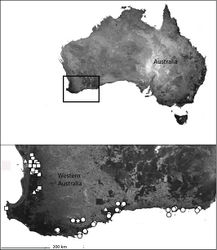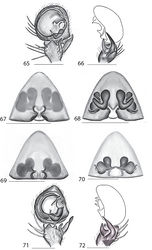Karaops toolbrunup
| Notice: | This page is derived from the original publication listed below, whose author(s) should always be credited. Further contributors may edit and improve the content of this page and, consequently, need to be credited as well (see page history). Any assessment of factual correctness requires a careful review of the original article as well as of subsequent contributions.
If you are uncertain whether your planned contribution is correct or not, we suggest that you use the associated discussion page instead of editing the page directly. This page should be cited as follows (rationale):
Citation formats to copy and paste
BibTeX: @article{Crews2011ZooKeys99, RIS/ Endnote: TY - JOUR Wikipedia/ Citizendium: <ref name="Crews2011ZooKeys99">{{Citation See also the citation download page at the journal. |
Ordo: Araneae
Familia: Selenopidae
Genus: Karaops
Name
Karaops toolbrunup Crews & Harvey, 2011 sp. n. – Wikispecies link – ZooBank link – Pensoft Profile
Type material
Holotype female (WAM T76592): Stirling Range National Park, Toolbrunup, 34°23'24"S, 118°03'14"E, scree slope, Western Australia, Australia, 5.IV.2004, M.S. Harvey, J.M. Waldock, K. Edward, C. Poustie, under rocks. Paratype: same data as for the holotype, 1♂ (WAM T62231).
Other material examined
AUSTRALIA: Western Australia: Stirling Range National Park, Toolbrunup, 34°23'22.9"S, 118°03'12.8"E, 7.II.2009, S.C. Crews, under rocks on scree slope, 3♀, 1♂, 3 immatures (WAM T97234-T97240).
Etymology
The specific epithet refers to the type locality, which means ‘drizzle carrier’ in the indigenous Nyoongar language. The name is to be treated as a noun in apposition.
Diagnosis
This species can be separated from most others by having 4 teeth on the cheliceral promargin, and from Karaops francesae sp. n. by genitalic characteristics. In the male, the cymbium is pointed distally, and the base of the embolus extends to the basal margin of the cymbium (Fig. 71). In the female, epigynal pockets are present and the sperm ducts are not coiled (Figs 69–70).
Description
Female (holotype):Color: carapace yellow-brown, with slightly darker marks laterally and medially; sternum pale yellow-brown; chelicerae pale yellow with darker infuscations anteriorly; maxillae pale yellow-brown, lightening distally; labium pale yellow-brown, lightening distally; abdomen dorsally pale creamy-yellow with a few darker flecks; ventrally pale yellow-brown; legs with segments clearly annulated, but annulations do not completely encircle femorae, legs darkening distally at tibiae; annulations lighter in centers giving a ‘leopard spot’ appearance. Cephalothorax: setae long and thin; 0.84 times longer than broad; fovea longitudinal, broad, very shallow. Eyes:AER nearly straight; PER slightly recurved; PME larger than AME, PLE largest, ALE smallest; eye group width 1.89; eye diameters, AME 0.19, ALE 0.13, PME 0.29, PLE 0.42; interdistances AME-ALE 0.52, PME-PLE 0.38, ALE-PLE 0.38, AME-PME 0.04; ocular quadrangle AME-AME 0.21, PME-PME 0.77; clypeus 0.06 high. Mouthparts:chelicerae with a few stout setae medially and anteriorly; lateral boss present, smooth; promargin with 4 teeth, retromargin with 3 teeth; maxillae longer than broad, with tuft of conspicuous setae distally; labium distally rounded. Sternum:0.89 times longer than broad, posteriorly indented. Pedipalp:tarsus slightly swollen, claw present with c. 6 teeth. Legs:leg I much shorter than legs II, III and IV; leg formula 3241; scopulae absent on all legs; tarsus I–IV with strong claw tufts; pr claws with c.10–15 teeth, rl claws with 1 or 2 teeth; spination: leg I, Fm L pr 2–1–0, d 1–1–1–1, rl 0 R pr 1–1–0, dorsal 1–1–1, rl 0; Ti d 0, v 2–2–2–2–2–2; Mt v 2–2–2–2; Ti and Mt I and II with strong spines; leg II, Fm pr 0, d 1–1–1, rl 0; Ti v 2–2–2–2–2–2; Mt v 2–2–2–2; leg III, Fm L pr 0, d 1–1–1–1, rl 0; R pr 0, d 1–1–1, rl 0; Ti 0; Mt 0; leg IV, Fm L pr 0, d 1–1–1, rl 0–0–1; R pr 0, d 1–1–1–1, rl 0; Ti v 1–1; Mt 1–0. Abdomen:terminal setal tufts present. Epigyne:lateral lobes indistinct, small comma-shaped sclerotizations in posterior third of plate where copulatory openings are located, epigynal pockets present; internally, ducts not coiled, small ducts lead to ovoid spermathecae, fertilization ducts located posteriorly, posterodorsal fold absent (Figs 69–70). Dimensions: Total length 8.89. Cephalothorax length 3.83, width 4.54. Sternum length 2.1, width 2.36. Abdomen length 5.06, width 4.44. Pedipalp: Fm 1.15, Pt 0.80, Ti 0.86, Ta 1.38, (total) 4.19. Leg I: Fm 4.29, Pt 1.91, Ti 3.81, Mt 3.23, Ta 1.15, (total) 14.39. Leg II: Fm 5.38, Pt 1.91, Ti 4.45, Mt 3.81, Ta 1.66, (total) 17.21. Leg III: Fm 5.58, Pt 1.72, Ti 5.92, Mt 3.70, Ta 1.53, (total) 18.45. Leg IV: Fm 5.57, Pt 1.72, Ti 4.44, Mt 3.70, Ta 1.44, (total) 16.87.
Male (paratype): Color: carapace yellow-brown, with slightly darker marks laterally and medially; sternum pale yellow; chelicerae pale yellow with darker infuscations anteriorly; maxillae pale yellow-brown, lightening distally; labium pale yellow-brown, lightening distally; abdomen dorsally pale creamy-yellow with a few darker flecks; ventrally pale yellow-brown; legs with segments clearly annulated, but annulations do not completely encircle femorae, legs darkening distally at tibiae; annulations lighter in centers giving a ‘leopard spot’ appearance. Cephalothorax:setae long and thin; 0.85 times longer than broad; fovea longitudinal, broad, very shallow. Eyes:AER nearly straight; PER slightly recurved; PME larger than AME, PLE largest, ALE smallest; eye group width 1.65; eye diameters, AME 0.19, ALE 0.11, PME 0.27, PLE 0.34; interdistances AME-ALE 0.46, PME-PLE 0.36, ALE-PLE 0.31, AME-PME 0.1; ocular quadrangle AME-AME 0.15, PME-PME 0.61; clypeus 0.06 high. Mouthparts:chelicerae with a few stout setae medially and anteriorly; lateral boss present, smooth; promargin with 4 teeth, retromargin with 3 teeth; maxillae longer than broad, with tuft of conspicuous setae distally; labium distally rounded. Sternum: 0.93 times longer than broad, posteriorly indented. Pedipalp: femur, spination dorsal 0–1–2; retrolateral tibial apophysis with 2 processes, dorsal apophysis longer, bent ventrally at almost a right angle, tapered to a fine point ventrally, ventral apophysis, smaller, tapering; retrolateral basal cymbial process absent; cymbial scopulae absent, cymbium round to triangular, angled bottom right; conductor large, pointed at tip; embolus very long and slender, arising from a large ovoid base that tapers abruptly, beginning at 6 o’clock, terminating at 1 o’clock; MA ovoid, centrally depressed, with two processes, one small and unsclerotized, the other a sclerotized, blunt hook (Figs 71–72). Legs:leg I much shorter than legs II, III and IV; leg formula 4231; scopulae absent on all legs; tarsus I–IV with strong claw tufts; pr claws with many c.10–15 teeth, rl claws with 1 or 2 teeth; spination: leg I, Fm pr 1–1–1, d 1–1–1, rl 1–1–1; Ti d 0, v 2–2–2–2–2–2, rl 0–1; Mt v 2–2–2–2; Ti and Mt I and II with strong spines; leg II, Fm pr 1–1–1, d 1–1–1, rl 1–1–1; Ti v 2–2–2–2–2–2; Mt v 2–2–2–2; leg III, Fm pr 1–1–1, d 1–1–1, rl 1–1–1; Ti v 2–2–1, rl 0–1; Mt 2–1; leg IV, Fm pr 1–1–1, d 1–1–1, rl 1–1–1; Ti pr 1–0–0, v 2–2–2–2, rl 1–1–1; Mt 2–1–1. Abdomen:terminal setal tufts present. Dimensions: Total length 6.31. Cephalothorax length 3.46, width 4.07. Sternum length 2, width 2.16. Abdomen length 2.85, width 3.25. Pedipalp: Fm 1.08, Pt 0.62, Ti 0.57, Ta 1.15, (total) 3.42. Leg I: Fm 4.44, Pt 1.81, Ti 3.55, Mt 4.07, Ta 1.91, (total) 15.78. Leg II: Fm 5.36, Pt 1.91, Ti 4.96, Mt 4.44, Ta 1.81, (total) 18.48. Leg III: Fm 5.62, Pt 1.99, Ti 4.91, Mt 4.25, Ta 1.73, (total) 18.40. Leg IV: Fm 5.53, Pt 1.68, Ti 5.15, Mt 4.44, Ta 1.90, (total) 18.70.
Natural history
Collected from under rocks on a scree slope (Figs 95, 101).
Distribution
The type locality only (Map 6).
Original Description
- Crews, S; Harvey, M; 2011: The spider family Selenopidae (Arachnida, Araneae) in Australasia and the Oriental Region ZooKeys, 99: 1-104. doi
Images
|


